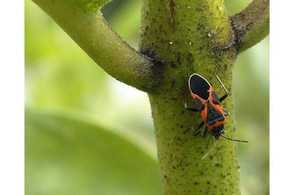Plants are the primary producers in an ecosystem, and thus the cornerstone of the food web. They capture light from the sun and are the starting point through which energy enters ecosystems.
In a healthy, natural ecosystem, plants are eaten by a wide range of insects and other invertebrates, as well as by larger animals. Mammals eat the leaves of plants, and birds and other animals eat fruits, seeds, nuts, and other parts of plants. But birds and insect predators also prey on the small insects and insect larvae that eat the leaves, stems, roots, and juices of plants.
Plants and insects co-evolve, and insects are often very specialized in what they eat. When people introduce plants to a new area, they typically don't bring any or all of the insects and other animals that eat the plant to this area, and often, the plant won't be eaten by as many native insects.
With fewer or no local insects or other herbivores eating the plant, the plant creates a "dead zone" in the food web, reducing insect biodiversity and indirectly reducing the diversity of birds and other larger animals as they have less insect food to eat.
By planting native plants, you help protect and restore this biodiversity by supporting the whole food web!



















 The Shaming of Femininity and Elevation of Masculinityon 07/13/2017
The Shaming of Femininity and Elevation of Masculinityon 07/13/2017
 What is Genderqueer or Non-Binary Gender?on 10/16/2015
What is Genderqueer or Non-Binary Gender?on 10/16/2015
 Resources for Learning Spanish Free Onlineon 04/13/2016
Resources for Learning Spanish Free Onlineon 04/13/2016
 Ways Native Plants Can Help Control Invasive Plantson 05/26/2016
Ways Native Plants Can Help Control Invasive Plantson 05/26/2016



Comments? Questions? Feedback?
In Britain we are re-establishing wild flower meadows. Meadows were an old form of agriculture, in which fields were allowed to grow with grass and flowers, and only mowed after the flowers had seeded. This meant that the flowers regrew annually. Silage cutting saw an end to many of these, as silage cutting meant that meadows were cut too early for the flowers to thrive, and the fertilizer applied by farmers was too much for most wild flowers to handle. Nowadays we are reversing the damage. Prince Charles is giving a lead by establishing meadows on his ecologically managed estate. Highgrove, and there are now others.
But one thing to bear in mind if you want to plant wildflowers or rare natives is that many require a less nutrient rich soil than many ornamental flowers do. On the Isle of Wight the National Trust re-established some wild native flowers near the cliff tops on one of its farms by taking up the rich, fertilized turf and putting a poorer quality turf down. The native wildflowers they wanted then thrived.
I think that it's probably impossible to totally reverse the ecological damage done--but I think that our choices from this point forward can influence whether we make things a lot better and restore a great deal of what is lost, or whether we continue to do more damage.
Growing with native plants isn't just about avoiding invasives, it's about restoring and protecting the populations of the native plants. Every time you plant a locally native plant, you're not only supporting the population of that plant, but you're supporting everything that depends on it. And that can be big. I even notice big differences in just adding a single plant to my yard or garden.
For example, I let a little patch of grass grow up with a common wildflower, white snakeroot, that is native to my region, and within a few months it was teeming with life: ants, flies, aphids, leaf borers, beetles, praying mantises, and then bees and butterflies showed up on the flowers when it bloomed, and then the seeds blew all over and native sparrows showed up to eat them. And I see this wildflower, which has wind-dispersed seeds, coming up in wild areas near my property too. And this is all from a single plant species!
Every little thing makes a difference, and I think there's huge reason to be both optimistic and enthusiastic about gardening with native plants. The results, which I've seen firsthand, can be astounding.
The trouble is that the geni is out of the bottle. There are so many introduced plants in Britain that many are now regarded as effectively native. What is a serious problem is nurseries buying cheap foreign stock of plants that should be available at home, and this has led to the introduction of plant pathogens. Dutch elm disease has effectively made the elm tree an endangered species in Britain, and Ash Die Back has done damage to our native ash trees, and imported plants are suspected.
Thank you! And yes, that's definitely true that these introduced plants can harbor diseases which can devastate populations of closely-related native plants.
Great article! I hope you can convert some people. Well done.
What a nice article. Although I am not much of a gardener, I agree with the logic of using native species.